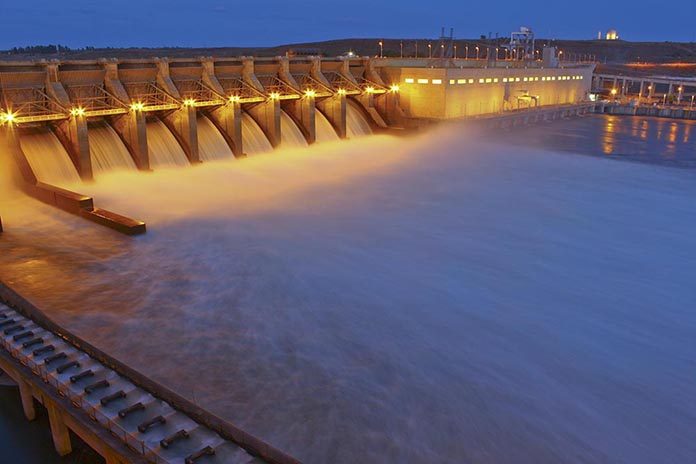
By Mia Maldonato
The U.S. Army Corps of Engineers and the Bureau of Reclamation said they will update an environmental study on the management of federal dams along the Columbia and Snake rivers.
The agencies will prepare a supplemental environmental impact statement analyzing new environmental data that a 2020 study, which evaluated the operations and maintenance of the 14 federally managed dams throughout the Columbia River Basin, did not address.
The new data that will be considered under the supplemental study includes a 2022 paper, Rebuilding Interior Columbia Basin Salmon and Steelhead and the 2024 Tribal Circumstances Analysis. Both identify breaching the lower Snake River Dams located in Washington as the greatest opportunity to restore salmon and steelhead populations in the basin.
The 2020 study, known as the Columbia River System Operations Final Environmental Impact Statement, implemented a plan to keep the lower Snake River dams in place. Shortly after, it was challenged in court by 10 entities – including the Idaho Conservation League, the states of Oregon and Washington, the Nez Perce, Umatilla, Warm Springs, and Yakama tribes, and other environmental nonprofits.
In December 2023, the parties, who are represented by the environmental legal nonprofit Earthjustice, agreed to a 10-year legal pause while they collaborate on an updated fish restoration plan. Tuesday’s decision to create a supplemental study is an important step in fulfilling that goal, according to a statement from Earthjustice.
“The information available now provides us with all we need to chart a successful path forward,” Earthjustice Senior Attorney Amanda Goodin said in a press release Tuesday. “We know we can avoid extinction and rebuild salmon and native fisheries to a healthy and harvestable abundance if we commit to the centerpiece actions they need, including breaching the four lower Snake River dams and replacing their services.”
Environmental groups applaud move to update study, calling 2020 study ‘flawed’
Environmental advocates say the previous 2020 study was flawed, and a revision would help restore and prevent extinction of salmon and steelhead populations.
“We appreciate the decision to do a supplemental process to address these flaws and evaluate stronger measures in how we operate the hydropower system including breaching the lower Snake River dams,” Sierra Club’s Snake and Columbia River Salmon Campaign Director Bill Arthur said in a press release. “Extinction is not an option, and that is the trajectory we are on without stronger actions.”
Today, four of the 16 salmon stocks in the Columbia and Snake Rivers are extinct. This includes Snake River coho, Mid-Columbia coho, Upper Columbia coho and Mid-Columbia sockeye.
Additionally, 13 salmon and steelhead stocks in the Columbia River Basin are listed as threatened or endangered under the Endangered Species Act.
Federal, state, and tribal agencies have collaborated to restore salmon and steelhead populations in the Columbia River Basin. While some progress has been made compared to the 1990s, when annual runs in the basin declined to around 1 million fish, current numbers remain far from historic levels of 10 to 16 million fish per year. Officials are also falling short of the goal to restore 5 million salmon and steelhead to the basin by 2025.
“Federal agencies have been wrong over and over about the impact of dams on salmon,” Idaho Conservation League Salmon and Energy Strategist, Mitch Cutter, said in a press release. “This supplemental environmental study is a chance for them to do right by tribes, river communities and anyone else who depends on the wealth of Northwest rivers for their lives and livelihoods.”
Hydropower coalition calls on federal government to withdraw review, calling it ‘misleading’
A coalition of power, navigation and agriculture groups across the Pacific Northwest is urging the federal government to withdraw its decision to initiate a supplemental study of the Columbia and Snake River dams.
The coalition, known as the Columbia Basin Regional Alliance for Transparency, includes Public Power Council, the Pacific Northwest Waterways Association, Northwest RiverPartners, Northwest Requirements Utilities, and other Pacific Northwest stakeholders. The coalition is dedicated to preserving hydropower and river commerce activities across the Columbia and Snake rivers.
In a press release, the coalition said a supplemental review would be premature, unnecessary and mislead the public about the role dams have to support the economy and the environment.
Hydropower is the largest source of energy in the Pacific Northwest, providing about 50% of the region’s annual energy generation, according to the Northwest Power and Conservation Council.
The Columbia and Snake River system also provides an efficient transportation route for moving agricultural products from Idaho, Washington and Oregon to global markets. The four Lower Snake River dams create a navigable waterway with their lock system, enabling goods to travel from the Port of Lewiston to the Port of Portland, where they are prepared for export.
“The proposed environmental review could lead to breaching federal hydropower facilities that serve as the largest source of affordable, reliable, clean energy for millions of people in the region while also providing world-class, clean river transportation for the regions and nation’s economies,” the coalition released in a statement.
Federal agencies accepting public comment for supplemental study
The U.S. Army Corps of Engineers and the Bureau of Reclamation are asking federal, local and state agencies, Native American tribes, and the public to submit comments relevant to the supplemental plan by March 20.
The agencies will host three virtual public meetings the week of Feb. 10. Details of those meetings will be posted on the project website early in the new year, according to the U.S. Army Corps of Engineers.
To learn more about the project or to submit public comment, visit the U.S. Army Corps of Engineers website.
This story appeared in the Oregon Capital Chronicle.









